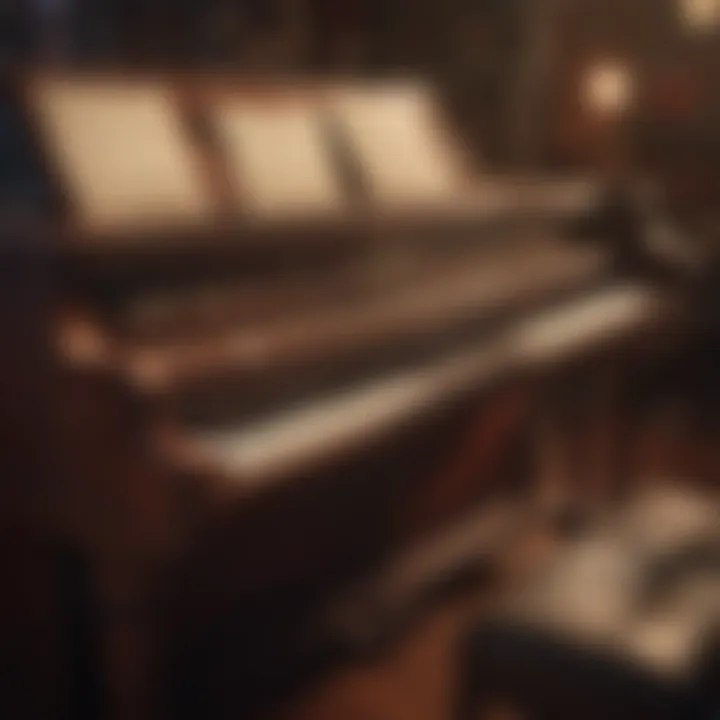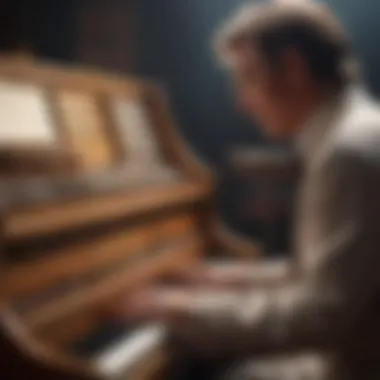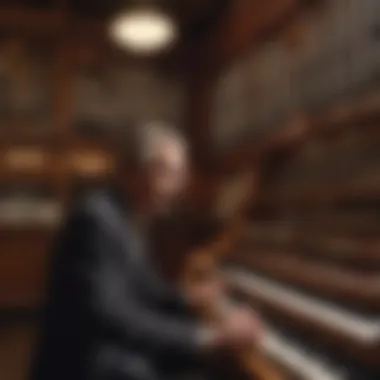The Hammond Organist: A Deep Dive into Musical Mastery


Intro
The Hammond organ, an emblem of innovation in the music space, has carved its own niche in the fabric of jazz and popular music. Understanding the art of the Hammond organist requires both an appreciation of the instrument’s technical features and a broader awareness of its historical evolution. This exploration probes into the rich tapestry of experiences, skills, and knowledge that define the Hammond organist’s journey.
The article will not only track the evolution of the Hammond organ but also identify and analyze the artistic contributions of key figures in this domain. Through this narrative, readers will gain insights into the mechanics of the instrument and the unique techniques utilized by notable players, transcending beyond mere performance to highlight the cultural significance of the Hammond organist within various music genres.
Furthermore, by examining the life stories of influential Hammond organists, the discourse aims to inform about the intricate relationships between these musicians and their instrument. The impact of the Hammond organ on jazz and popular music, alongside its technical adaptability, positions this subject as relevant in both academic and artistic discussions.
In this context, it is essential to lay a foundation that showcases the importance of the Hammond organist in crafting meaningful music experiences.
Prologue to the Hammond Organ
The Hammond organ holds a distinct place in the narrative of modern music. Often considered a transformative instrument, it has shaped various genres including jazz, soul, and rock. Understanding the Hammond organ is essential for appreciating its historical significance and the evolution of sound in the music industry. This section will delve into the instrument's rich past and its technical specifications, which contribute to its ongoing relevance.
Historical Background of the Hammond Organ
The Hammond organ was invented by Laurens Hammond in 1935. It emerged during a time when there was a growing demand for a cost-effective substitute for traditional pipe organs. The original design was known as the Hammond Model A. Several factors led to its popularity: the ability to produce a wide range of tones, portability, and affordability compared to pipe organs. By the 1940s and 1950s, it had gained significant traction in jazz clubs and church services alike.
The instrument's distinctive sound comes from its unique use of tonewheels and an electromechanical system, which set it apart from electronic keyboards that would come later. Notably, the Hammond B-3, introduced in 1955, became synonymous with jazz and rhythm and blues music. Artists such as Jimmy Smith and Booker T. Jones brought the organ into the spotlight, showcasing its versatility. Over the decades, the Hammond organ became an integral part of many music scenes, adapting and evolving with the times.
Technical Specifications of the Hammond Organ
The Hammond organ operates on a principle that combines both mechanical and electrical elements. Its tone generation involves rotating metal tonewheels that create sound through electromagnetic induction. Each wheel corresponds to a specific note, thus enabling varying pitches and tones.
Key technical features include:
- Drawbars: These sliders allow musicians to adjust the volume of different harmonic components, providing versatility in tone.
- Percussion: A feature allowing for a sharper attack on specific notes, enhancing expressiveness.
- Leslie Speaker Compatibility: The Hammond organ works seamlessly with Leslie speakers, adding a rich, swirling sound that becomes characteristic in many performances.
Musicians appreciate the warm, rich sound quality that the Hammond organ offers. This quality is achieved through its unique construction and the specific tonal characteristics it delivers. Understanding these technical aspects is vital for anyone wishing to master the instrument or simply appreciate its role in shaping musical history.
The Role of the Hammond Organist
The importance of the Hammond organist extends far beyond their technical skills. They serve as vital intermediaries between the instrument and the audience, shaping the sound and emotional landscape of various musical genres. The Hammond organ, initially popularized in the mid-20th century, became a staple in jazz, soul, and rock music. The organist's role involves not only playing notes but also creating an atmosphere that resonates with listeners.
Defining the Hammond Organist
A Hammond organist is a musician who specializes in playing the Hammond organ, a revolutionary instrument that has had significant impacts on various music styles. The organist must understand the complex mechanisms behind the instrument, including its drawbars, pedals, and tonal variations. Being a Hammond organist requires a balance of technical proficiency and artistic expression. They often work in settings ranging from small jazz clubs to large concert venues, adapting their playing style to the environment and audience. Moreover, the Hammond organist holds a unique position in ensemble performances, frequently taking the lead while also backing other instrumentalists.
Skills and Techniques of Hammond Organists


Hammond organists possess a diverse set of skills that allow them to excel in their craft. These include:
- Technical Proficiency: Mastery over the organ's keys and unique features, like the leslie speaker, grants the organist the ability to produce a range of sounds.
- Improvisation: The ability to improvise is crucial, especially in genres like jazz. Hammond organists often need to think quickly and creatively, responding to the music and fellow musicians in real-time.
- Pedal Technique: Using the foot pedals effectively is essential for creating a fuller sound and maintaining rhythm within a performance. This technique allows organists to play bass lines while simultaneously managing melodies on the keys.
- Understanding Tonal Variation: Hammond organists use drawbars to manipulate sound such as richness and depth. This skill allows them to tailor their sound for different musical contexts, enhancing the overall performance.
Genres Influenced by the Hammond Organ
The Hammond organ has played a significant role in various music genres, impacting the sound and style of countless artists. Its unique tonal quality and versatility have allowed it to transcend musical boundaries. From jazz to rock, the Hammond organ has shaped the evolution of these genres and created a distinctive sound that continues to resonate today.
Jazz and the Evolution of Hammond Jazz
Jazz has been at the forefront of the Hammond organ's influence. The instrument became popular in jazz settings during the 1950s and 1960s. It provided musicians with a rich, warm sound that complemented the improvisational nature of jazz music. The use of the Hammond organ in jazz opened new avenues for musical expression.
Artists such as Jimmy Smith and Larry Young pioneered the Hammond jazz style. They blended traditional jazz harmony with the organ's unique voice. Smith's fast-paced, energetic style and Young's experimental approach contributed immensely to the genre. The organ allowed for complex chord progressions and intricate melodies, enhancing the jazz landscape.
Characteristics of Hammond jazz include:
- Innovative improvisation: The organ's sound allows for extensive improvisation.
- Groove-oriented rhythm: Many jazz organists emphasize rhythm, creating a groove that draws listeners in.
- Rich harmonic textures: The drawbars and Leslie speaker enhance harmonic complexity, providing depth to performances.
"The Hammond organ revolutionized the sound of jazz, creating a new auditory experience that was both familiar and innovative."
Soul and R&B Contributions
The Hammond organ has also left an indelible mark on soul and R&B music. Its ability to create soulful melodies has made it a staple in the genre. Prominent figures such as Aretha Franklin and Ray Charles utilized the organ to deepen their emotional expression.
Soul music takes full advantage of the Hammond’s warm tones. It enhances both ballads and energetic tracks. For example, songs like "Green Onions" by Booker T. & the MG's exemplify the organ's signature sound. Their usage of the instrument helped to establish it as an iconic element of soul and R&B.
Key aspects of the Hammond organ in soul and R&B include:
- Emotional depth: The instrument's sound elicits strong emotional responses.
- Supportive backing: It provides harmonic support for vocal lines with its thick chords.
- Fusion of genres: Soul artists often blend influences from jazz, gospel, and rhythm and blues, making the Hammond a versatile choice.
Rock, Pop, and Beyond
In rock and pop music, the Hammond organ has been instrumental in crafting distinctive sounds that define various eras. Bands in the late 1960s and 1970s, such as The Doors and The Allman Brothers Band, embraced the Hammond organ to enhance their music.
The versatility of the Hammond allows it to fit seamlessly into different music styles. In rock, it often provides a driving force behind the melody, while in pop, it adds a lush texture to arrangements. Its characteristic sound can evoke nostalgia, making it a popular choice for contemporary artists as well.
Notable contributions of the Hammond organ in these genres are:
- Powerful solos: The instrument often features in solos, showcasing technical prowess.
- Layered soundscapes: It supports a wide range of musical styles, enriching compositions.
- Cultural impact: Many bands adopted the Hammond organ as a symbol of musical experimentation.


In summary, the Hammond organ's influence across genres displays its adaptability and distinct voice. As artists continue to explore its unique qualities, the Hammond organ remains an integral part of musical expression. Through jazz, soul, and rock, it has not only shaped these genres but has also ensured its legacy as an enduring instrument.
Prominent Hammond Organists Across History
The Hammond organ has been shaped by a number of exceptional musicians. These artists not only showcased their skill but also enriched various genres of music. Exploring their contributions is crucial in understanding the instrument's legacy. Each notable Hammond organist adds depth to the instrument’s narrative. Their influence is seen not just in music, but also in the voices they represent in the artistic community.
Jimmy Smith: The Innovator
Jimmy Smith stands as an iconic figure when it comes to the Hammond organ. Born in 1925, he transformed how the instrument was perceived in the realms of jazz. Smith introduced the organ as a lead instrument, which had been previously uncommon. His innovative approach combined blues, gospel, and jazz influences, creating a distinctive sound.
His album "Back at the Chicken Shack" is particularly noteworthy, showcasing his extraordinary improvisational skills. He skillfully employed drawbars to create varied tones, thereby giving depth to his performances. Smith's mastery elevated the Hammond organ’s status among musicians worldwide. His work has inspired countless organists who came after him, establishing a rich lineage of creativity.
Dr. Lonnie Smith: A Modern Maestro
Another prominent figure in the world of Hammond organists is Dr. Lonnie Smith. His career, spanning over six decades, highlights the continuity and evolution of the organ's musical language. Smith, who was born in 1942, incorporated elements of funk and soul into his style, further expanding the boundaries of what can be done with the Hammond organ.
He is known for his tight grooves and ability to blend genres seamlessly. Albums like "Dr. Lonnie Smith" showcase his unique improvisational techniques, making his playing both engaging and dynamic. Dr. Smith has influenced a younger generation of players, ensuring the relevance of the Hammond organ in modern music.
Other Notable Hammond Organists
The influence of the Hammond organ is not confined to just a few key figures. Many other organists have made significant contributions as well. Here are some noteworthy names:
- Larry Young: A pioneer in the jazz genre who blended modal jazz with the organ's sound.
- Booker T. Jones: Best known for his work with Booker T. & the MG's, he brought the organ into the pop and soul scene.
- Charles Earland: Known for his powerful performances, he fused jazz with elements of soul.
These musicians, among many others, have woven the Hammond organ into the fabric of American music. Their varied styles and explorations continue to shape the path for future organists and maintain the instrument’s cultural significance.
Technical Aspects of Playing the Hammond Organ
The technical aspects of playing the Hammond Organ are essential. This section will delve into key components that shape the sound and performance of this instrument. A deep understanding of these elements allows the Hammond organist to explore the full range of possibilities the organ offers. Mastery of these technical aspects will enhance the quality of performance and enable musicians to produce unique and rich sounds.
Understanding Drawbars and Their Functionality
Drawbars are crucial for crafting the unique sound of the Hammond organ. Each drawbar controls the volume of a specific harmonic of the organ’s sound. By pulling out or pushing in these drawbars, the organist can mix different harmonics, allowing for creativity in tone production. This enables musicians to create a variety of sounds, from smooth and jazzy to gritty and percussive.
- Fundamentals of Drawbars: They typically range from 1 to 9, with each number corresponding to a specific harmonic. The first drawbar usually produces the fundamental tone, while later drawbars add higher harmonics.
- Usage and Technique: Experienced organists manipulate drawbars in real-time while playing. This requires coordination and an understanding of how harmonics blend. The transition from soft to loud tones can also be achieved through drawbar adjustments.
- Importance in Performance: Drawbars allow for personalization. Each player’s signature sound can be developed through the choice and manipulation of drawbars. This is a significant skill for any Hammond organist.
The Leslie Speaker: An Iconic Complement
The Leslie speaker is another iconic element in the world of Hammond organs. Named after its inventor, Donald Leslie, this speaker creates a rotating sound that is integral to the organ's signature tone. The swirling effect it produces enhances depth and richness in music.


- Mechanics of the Leslie Speaker: It operates using a unique design that combines a rotating horn and a stationary tweeter. The rotation creates variations in sound intensity and pitch, leading to the distinctive vibrato effect.
- Integration with Hammond Organ: Many organists pair the Hammond with a Leslie speaker to achieve a fuller sound. The combination is particularly effective in jazz and gospel music. The interaction between the organ and Leslie enriches the harmonic structure of the sound.
- Performance Considerations: Understanding how to balance the organ with the Leslie speaker is essential. Adjusting speed settings and placement can dramatically change the overall sound.
Creating Unique Sounds with Effects
The use of effects is significant in expanding the sonic capabilities of the Hammond organ. Effects can transform a basic sound into something entirely unique, allowing the organist to explore new musical landscapes.
- Types of Effects: Common effects include reverb, delay, and distortion. Each effect alters the sound in different ways. Reverb adds space, delay creates echoes, and distortion adds grit.
- Implementation and Technique: Organists often layer effects to achieve a desired outcome. This requires a good ear and sense of timing. Live performances benefit particularly from creative use of effects to engage the audience.
- Impact on Genre: Different music genres utilize effects distinctively. For instance, in rock music, distortion can make the sound more aggressive, while in jazz, subtle reverb can add atmospheric depth.
The technical elements combined with creative expression define an organist’s sound.
Overall, mastering the technical aspects of the Hammond organ allows players to realize their full artistic potential. This knowledge extends to live performances, recording sessions, and personal experimentation. The Hammond organ, with its rich capabilities, continually inspires organists to evolve and innovate.
The Future of the Hammond Organist
As we look ahead, the future of the Hammond organist appears to be an intersection of tradition and innovation. While the roots of the Hammond organ run deep in jazz and soul, its evolution continues to shape the musical landscape. Understanding the future of the Hammond organist involves examining the impact of technological advancements, as well as the necessity of preserving the foundational techniques that underline the craft. This duality reflects the ongoing dialogue between modernity and heritage in music.
Digital Advancements and Organ Technology
The digital age has heralded significant changes in how music is created and performed. Digital technologies have made the sounds of the Hammond organ more accessible than ever before. Advanced software emulations, such as the Native Instruments Komplete 13 and Arturia B3-V, provide organists with powerful tools. These programs replicate the rich tonal qualities of the original instrument, allowing musicians to experiment with sound in new ways.
Furthermore, hardware developments have seen the creation of digital organs that incorporate traditional sounds with modern capabilities. Instruments like the Nord C2D and Hammond SKX allow players to integrate various effects and rhythms. This capability opens up new avenues for creativity, encouraging exploration and experimentation among organists.
Despite these advancements, it is vital to recognize that technology should complement rather than replace traditional skills. While digital tools make it easier to produce music, they cannot replicate the unique qualities of a live performance. Understanding how to balance these new tools with classical techniques is essential for the evolution of the Hammond organist's craft.
Preserving Traditional Techniques in a Modern Era
As much as technology shapes the future, the essence of what it means to be a Hammond organist lies in mastering core techniques. Techniques such as proper registration using drawbars, deep understanding of tonewheels, and the art of playing with a Leslie speaker are foundational skills. These elements ensure that organists not only appreciate the instrument's history but also retain authentic sound in their music.
To preserve traditional techniques, educational institutions and online platforms must prioritize teaching these methods. Masterclasses and workshops led by veteran organists can bridge the gap between old and new. Organizations like the American Organist Association and local music schools play a crucial role in this preservation.
Ending: The Enduring Legacy of the Hammond Organist
The Hammond organist has played a pivotal role in the evolution of music, particularly in jazz, soul, and rock genres. This legacy is not simply a matter of historical record; it reflects an ongoing dialogue between musicians, their instruments, and the audiences that engage with their art. The importance of this topic lies in understanding how the contributions of Hammond organists shaped not only their respective genres but also influenced musical techniques and ideologies that permeate modern music.
Hammond organists have utilized their instrument to convey emotion, innovate sound, and define musical arrangements. Their unique ability to blend technical skills with artistic interpretation has led to a distinctive sound that resonates across various musical landscapes. The enduring nature of this legacy can be observed through numerous recordings and performances that continue to inspire both upcoming musicians and established artists alike.
A Reflection on the Influence of the Hammond Organ
The influence of the Hammond organ extends beyond mere presence in a musical composition. First, it has become synonymous with certain sounds in modern music. The rich tones and distinct vibrato capabilities of the Hammond have created an atmosphere that enhances the overall auditory experience.
Additionally, the techniques employed by Hammond organists have set a precedent for instrumental versatility. Many organists have embraced various styles, leading to innovations within their playing methods. From intricate improvisations in jazz to soulful grooves in R&B, the applications of the Hammond organ are vast.
"The Hammond organ never fails to bring an emotional depth and complexity to a sound. Its versatility has made it the backbone of many musical styles."
The instrument's design and functionality have also spurred creativity among musicians. Understanding drawbars and the interplay with Leslie speakers allows performers to create an array of unique audio textures. This blending of technical understanding with creative expression embodies the essence of the Hammond organist's artistry.
As we look to the future, it becomes essential to appreciate the efforts of these musicians not only in their historical context but also in current and future musical movements. Their imprint on the music industry ensures that the Hammond organ will remain a cherished instrument, contributing to the evolution of sound for generations to come. Finally, recognizing their legacy inspires new players to explore and expand the boundaries of what is possible with the Hammond organ.



